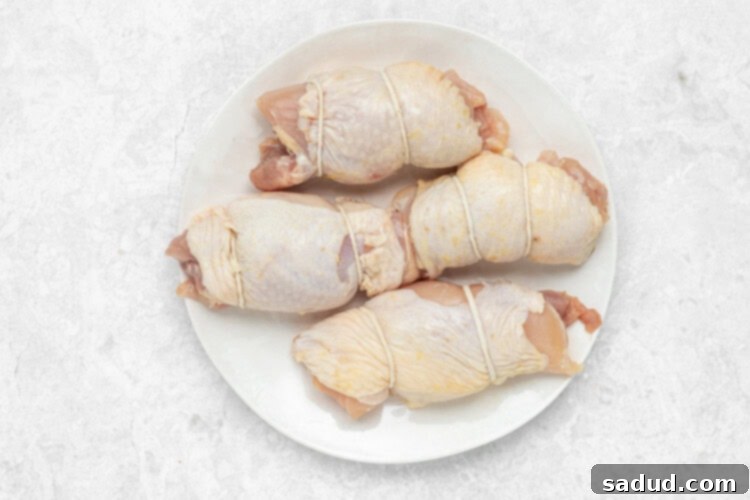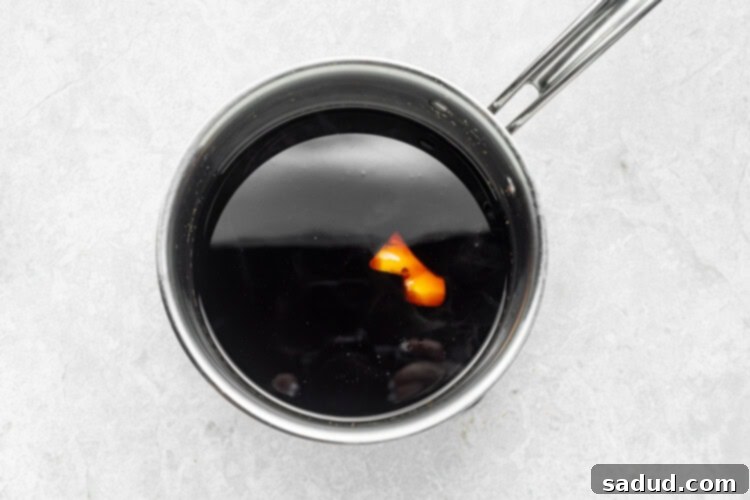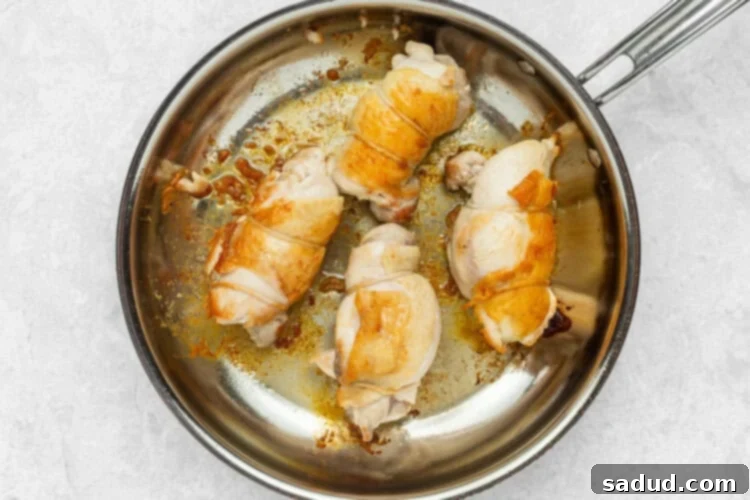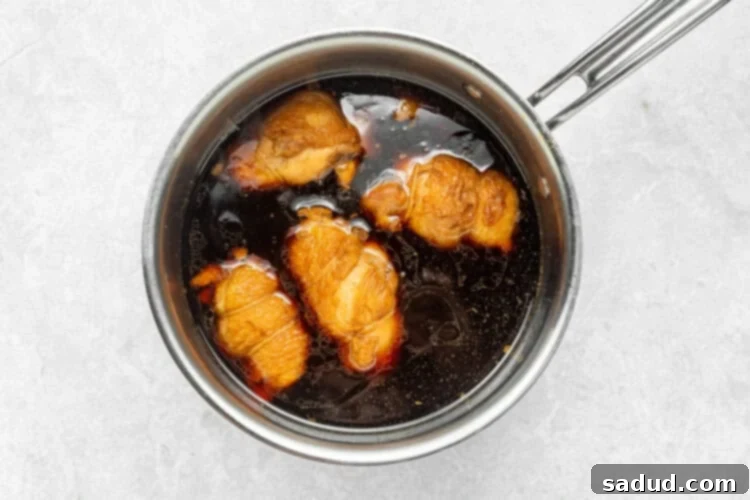Tender & Juicy Chicken Chashu: The Ultimate Homemade Japanese Braised Chicken Thighs Recipe
Welcome to your new favorite comfort food! This incredible Chicken Chashu recipe delivers perfectly savory and sweet flavors, reminiscent of your favorite ramen shop, right in the comfort of your own home. Rolled boneless, skin-on chicken thighs are lovingly braised in a rich, aromatic broth until they reach an unparalleled level of tenderness and juiciness. Prepare to impress your taste buds and elevate your weeknight meals with this restaurant-quality dish that’s surprisingly simple to master and explodes with delightful flavor in every bite.

Why This Homemade Chicken Chashu Recipe Shines
There are countless reasons why this easy chicken chashu recipe is destined to become a staple in your kitchen. Beyond its straightforward preparation, it offers a depth of flavor and satisfying texture that truly sets it apart.
- A Symphony of Flavors: Each piece of chicken is infused with an incredible umami-rich braising liquid, boasting a perfect balance of savory and sweet notes. The skin crisps beautifully during the initial searing, while the meat becomes melt-in-your-mouth tender as it soaks up all the delicious broth. This isn’t just chicken; it’s a taste experience that will leave your palate thoroughly satisfied.
- Restaurant Quality, Home Kitchen Simplicity: You don’t need to be a professional chef to create this impressive dish. Despite its sophisticated taste, the steps are incredibly straightforward. You’ll simply roll the chicken thighs, give them a quick brown in a skillet to lock in flavor and texture, then let them simmer away in a fragrant blend of soy sauce, mirin, sake, and other aromatics. The entire process comes together in just about 30 minutes of active cooking, making it ideal for busy weeknights or a special weekend treat.
- The Perfect Harmony of Sweet and Savory: What truly makes this chashu irresistible is its expertly balanced flavor profile. The deep, salty notes of soy sauce and the tangy, slightly sweet acidity of mirin are beautifully complemented by a touch of sugar, creating a glaze that’s both rich and bright. Fresh ginger adds a warm, aromatic spice, elevating the overall complexity without overpowering the delicate chicken.
- Incredibly Versatile: While traditionally known as a ramen topping, this chicken chashu is far more adaptable. Serve it thinly sliced over steamed rice for a quick and satisfying donburi bowl, tuck it into bao buns, or even add it to salads for an Asian-inspired twist. Its rich flavor means it stands wonderfully on its own as a main protein too.
Essential Ingredients for Perfect Chicken Chashu
Crafting exceptional chicken chashu begins with selecting the right ingredients. Each component plays a crucial role in developing the signature flavor and texture of this beloved Japanese dish.
- Boneless, Skin-On Chicken Thighs: This is non-negotiable for authentic chashu. Boneless thighs allow us to tightly roll the chicken, ensuring uniform cooking and making it easier to slice once cooked. The skin is absolutely vital; it renders down during braising, adding moisture and richness to the broth, and creates a beautifully golden-brown, slightly crispy exterior during the initial searing step. Its fat also contributes significantly to the overall flavor and tenderness.
- Soy Sauce: The backbone of our braising liquid, soy sauce provides the essential umami and savory depth. For a healthier option without compromising flavor, consider using low-sodium soy sauce. If you’re sensitive to gluten or cooking for those with dietary restrictions, always opt for a gluten-free alternative like tamari. Different brands of soy sauce can vary in saltiness and depth, so taste and adjust as needed.
- Mirin: This sweet Japanese rice wine is indispensable. Similar to sake but with a lower alcohol content and higher sugar level, mirin adds a subtle sweetness, a beautiful glossy sheen to the chicken, and a crucial layer of umami. Its acidity also helps to balance out the richness of the soy sauce, bringing all the flavors into harmony. If genuine mirin is unavailable, rice vinegar or dry sherry can be used as a substitute, though you might need to slightly increase the sugar content.
- Sake or Dry White Wine: Sake, a traditional Japanese rice wine, infuses the braising liquid with a delicate complexity and umami, enhancing the overall authenticity of the dish. If sake isn’t readily available, a good quality dry white wine is an excellent substitute. I recommend a crisp Sauvignon Blanc, an unoaked Chardonnay, or any wine described as “crisp” or “dry” to avoid adding unwanted sweetness. For an alcohol-free version, simply substitute with an equal amount of additional mirin or even just water, though the flavor profile will be slightly different.
- Sugar: A crucial component for balancing the savory soy sauce and promoting that beautiful, caramelized glaze on the chicken. Regular granulated sugar works perfectly here. It contributes to the dish’s signature sweet-savory profile and helps to tenderize the chicken slightly during the long braise.
- Fresh Ginger: Adding a 2-inch knob of fresh ginger (peeled and thinly sliced or smashed) introduces a wonderful aromatic warmth and subtle spice that brightens the entire dish. It provides a fragrant counterpoint to the richness of the chicken and the sauce. While optional, it’s highly recommended for an authentic and vibrant flavor.
- Shallot: A single shallot, peeled and sliced in half, contributes a mild, sweet onion flavor to the braising liquid. Shallots are milder than regular onions and impart a nuanced sweetness that complements the other Japanese ingredients perfectly, further enhancing the depth of the sauce.
- Water: The base for our braising liquid, water helps to dilute the intense flavors of the other ingredients, creating enough liquid to fully immerse and tenderize the chicken thighs.
Chef’s Pro Tips for the Best Chicken Chashu
Achieving truly exceptional homemade chicken chashu is easy with a few expert insights. These tips will ensure your chicken is perfectly tender, flavorful, and beautifully presented.
- Secure the Rolled Chicken Thighs with Cooking Twine: This step is more important than it seems! Tightly rolling the chicken thighs with the skin side out and securing them with heat-safe, unbleached cooking twine ensures that the chicken maintains its compact, cylindrical shape throughout the cooking process. This uniform shape allows for even cooking and creates those appealing, round slices characteristic of chashu. Look for butcher’s twine, which is 100% safe for cooking and free of dyes or chemicals.
- Allow the Chicken to Cool in the Braising Liquid: Patience is a virtue, especially with chashu. Once cooked, resist the urge to immediately remove the chicken from the pot. Instead, let it cool completely, or at least for 10-15 minutes, submerged in the flavorful braising liquid. The longer the chicken remains in the warm liquid, the more it will soak up those incredible savory-sweet flavors, resulting in a more intensely flavored and unbelievably juicy final product. This also allows the chicken to rest and redistribute its juices, making it even more tender.
- Master the Browning Technique: Don’t rush the initial browning step. Searing the rolled chicken thighs in a hot skillet for 2-3 minutes per side creates a beautiful golden-brown crust and renders some of the fat from the skin. This not only adds a crucial layer of flavor and texture but also helps to seal in the juices before the slow braise. A well-browned exterior contributes significantly to the overall appeal and taste of your chashu.
- Versatile Serving Suggestions: While traditionally a star topping for homemade ramen (simply remove the twine, thinly slice, and add to your steaming bowl of soup), chicken chashu is incredibly versatile. It’s fantastic over a bowl of hot steamed rice, forming the base of a flavorful donburi. You can also shred it for sandwiches, incorporate it into stir-fries, or serve it alongside roasted vegetables for a complete meal. The rich braising liquid can also be reduced further into a glaze to drizzle over the finished chicken for an extra burst of flavor.
- Adjust Sweetness to Your Liking: The balance of sweet and savory is key in chashu. Feel free to adjust the amount of sugar according to your preference. If you prefer a less sweet profile, start with slightly less sugar and taste the braising liquid before adding the chicken. Remember, you can always add more, but you can’t take it away!
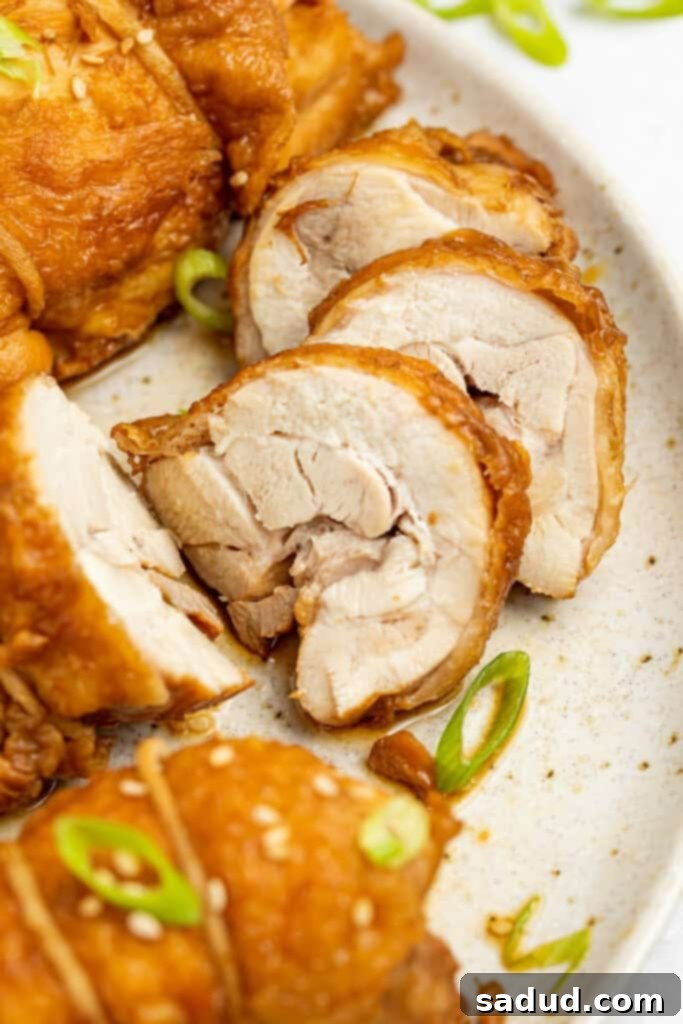
More Delicious Chicken Recipes You’ll Love
- Frozen Chicken Breast in the Air Fryer
- Chicken Pesto Sandwich
- Pecan Crusted Chicken with Honey Mustard Yogurt Sauce
- Air Fryer Chicken Legs
- Chicken Fricassee
If you loved this recipe as much as we did, don’t forget to leave us a review below. ★ Follow Easy Healthy Recipes on Pinterest, Facebook, and Instagram, too!
For more delicious recipes, visit our sister sites, 40 Aprons and Easy Cheap Recipes.

Chicken Chashu
 Cheryl Malik
Cheryl Malik
Print
SaveSaved!
Ingredients
- 1 pound boneless, skin-on chicken thighs
- 2 cups water
- 1 cup soy sauce (or low-sodium/gluten-free tamari)
- 1 cup mirin
- ½ cup sake or dry white wine (like Sauvignon Blanc)
- ½ cup granulated sugar
- 2-inch knob fresh ginger peeled and sliced (or smashed), optional but recommended
- 1 shallot peeled and sliced in half
Equipment
-
Cooking twine
-
Large skillet
-
Large pot
Instructions
-
Carefully roll each boneless, skin-on chicken thigh into a tight cylindrical shape, ensuring the skin faces outwards. Secure each roll firmly with cooking twine at regular intervals to maintain its shape during cooking.

-
Heat a large skillet over medium heat. Once hot, add the tied chicken thighs and lightly brown them for about 2-3 minutes per side. This step helps to render the fat, crisp the skin, and develop a deeper flavor.

-
In a large pot, combine the water, soy sauce, mirin, sake (or dry white wine), sugar, sliced ginger, and halved shallot. Place the pot over medium-high heat and gently boil, stirring occasionally, until the sugar has completely dissolved and the liquid is well combined.

-
Carefully add the browned chicken thighs into the pot with the braising liquid. Reduce the heat to a gentle simmer, cover, and cook for 20-25 minutes, or until the chicken is tender and cooked through. For maximum flavor, allow the chicken to cool slightly (at least 10 minutes) or even completely in the cooking liquid before serving.

Notes
- Make it Paleo: To adapt this recipe for a Paleo diet, simply substitute the regular soy sauce with coconut aminos and replace the granulated sugar with an equal amount of coconut sugar.
- Make it Sugar-Free: For a sugar-free version, use a granular sugar substitute like Swerve or your preferred sugar-free sweetener in place of regular sugar. Adjust to taste as different substitutes have varying sweetness levels.
- Storage and Reheating: Leftover chicken chashu can be stored in an airtight container with some of the braising liquid in the refrigerator for up to 3-4 days. To reheat, gently warm slices in a skillet or microwave with a splash of the liquid to prevent drying out.
- Creating a Glaze: After cooking, you can strain the braising liquid and reduce it over medium-high heat until it thickens into a glossy, concentrated glaze. Drizzle this over your sliced chashu for an extra layer of intense flavor and a beautiful presentation.
Recipe yields approximately 4 servings. Actual number of servings will depend on your preferred portion sizes.
Nutritional values shown are general guidelines and reflect information for 1 serving out of 4 using specific ingredients listed above. Actual macros may vary slightly depending on specific brands and types of ingredients used.
To determine the weight of one serving, prepare the recipe as instructed. Weigh the finished recipe, then divide the weight of the finished recipe (not including the weight of the container the food is in) by 4. Result will be the weight of one serving.
Nutrition Information
Number of total servings shown is approximate. Actual number of servings will depend on your preferred portion sizes.
Nutritional values shown are general guidelines and reflect information for 1 serving using the ingredients listed, not including any optional ingredients. Actual macros may vary slightly depending on specific brands and types of ingredients used.
To determine the weight of one serving, prepare the recipe as instructed. Weigh the finished recipe, then divide the weight of the finished recipe (not including the weight of the container the food is in) by the desired number of servings. Result will be the weight of one serving.

